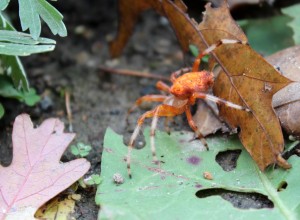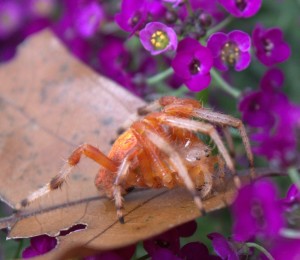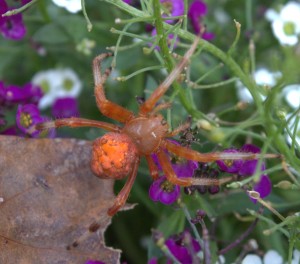What’s an orb weaver anyway? Some kind of spider that weaves large round nests!
This one drew my eye because of its bright orange color. Who wouldn’t notice that bright color crawling on the ground?

It tried to hide from me by creeping under an herb but I wasn’t done inspecting it yet. I scooped her up with a brown oak leaf and carefully placed the spider among the purple and white flowering alyssum next to the garden.

This orb-weaver was also a big spider — on the size of a mature garden spider. Not tarantula big, but it was larger than most house spiders.

It turns out this is a fairly common spider known as the Marbled Orb-Weaver, Araneus marmoreus. It’s a member of the spider family Araneidae, which includes thousands of species of spiders.
The orange color may make you think this spider is toxic, but it’s not. Not dangerous or toxic to you or your pets.
Adults do not overwinter. The species survives winter as eggs protected by a silken cocoon. Young spiders emerge from the cocoon in spring and grow into the adult forms by the middle of summer. Adults can be seen then until the first killing frost in autumn.
Seeing as it was late October when this female spider was photographed, she may have just laid her egg cocoon as her contribution to the survival of the species. If we look around this area next summer or fall we might be able to find her offspring. (The images above were taken in Central Pennsylvania on 30 October 2015.)
As gardeners we try to leave spiders alone. Sure, they’re kind of creepy and some people are quite afraid of them, but they do have a job to do. When that involves eating some of the garden pests, or irritating buggers like mosquitoes, I’m all too glad to let them live.
Go free! Eat and be merry!